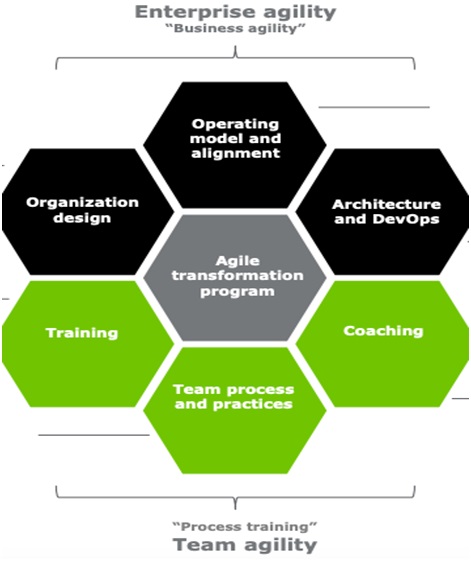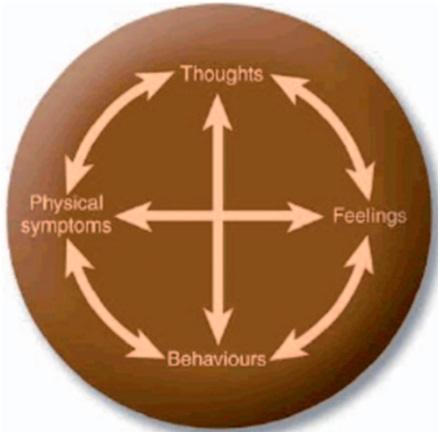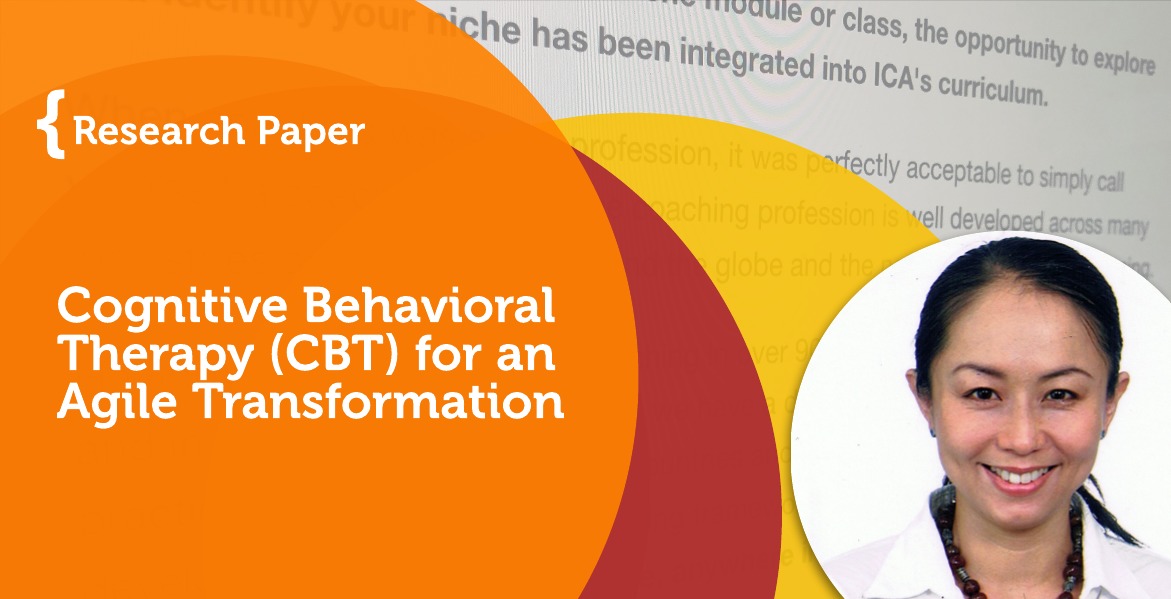Research Paper By Silky Fischer-Lee
(Executive Coach, SWITZERLAND)
Today, we live in a fast-changing world and work in a very competitive business environment. As organizations strive to adapt to the constant changes and reinvent the future, building the organizational ability to be agile has become one of the most popular topics among companies. This research reviews characteristic of agile transformations that many business organizations are striving for today and explore opportunities to integrate CBT in team coaching to build organizational capabilities for an agile transformation.
Business Agility and an Agile Transformation
Business agility can be defined as an organization’s ability to adapt and respond to market changes, customer demands, produce cost-effective cutting edge products and be a leader in the market (Agile Business Consortium, n.a.). Business agility is closely tied to employees’ ability to adapt, innovate, and be resilient dealing with uncertainty, complexity, and changes (Agile Business Consortium, n.a.). Many organizations are putting great effort to transform themselves into an agile organization, building business agility as a top priority.
To understand current agile transformations that are happening across geographies among many organizations, we need to understand where this agile concept in the context of business transformation has emerged from. The concept of agility has widely spread in the software development sector in the 1990s in the US, as opposed to the traditional software development approach. The traditional approach was characterized as micro-planned and micro-managed in a strictly regulated environment. This agile approach movement led to developments of agile frameworks and methodologies that motivated developers to experiment and take risks and learn faster. It allows them to focus on the delivery of customer-centric products.
The agile software development approach follows the twelve principles from the Agile Manifesto. These were written by 17 software developers from the US in 2001. The twelve principles are (Beck et al, 2001):
There are some interesting points we need to pay close attention to – how the teams were designed to deliver products. The teams are organized “to optimize flexibility, creativity, and productivity” (McGreal&Jochan, 2018, p. 152)
In essence, based on these twelve principles and the team model, the software development companies were able to make the development processes much faster and deliver more customer-centric products while flexibly responding to the constant market changes quickly and also boosting employee motivation (Biermann, 2019).
This agile approach from the software development sector started to draw great attention among many business organizations fast, as they dealt with constant changes in an extremely uncertain and competitive market.
According to Deloitte (See figure 1), organizations require two key elements that work together for a successful organizational agile transformation, namely, “enterprise agility” and “team agility”. The “enterprise agility” is concerned with the business model, which is related to an operating model, organizational design, architecture, and DevOps. The “team agility” on the other hand focuses on people, processes, and practices in teams through coaching and training. For a successful transformation, all these elements should be managed in a well-coordinated, systematic manner, as they are closely connected and complement each other.
 Figure 1. Building Blocks of an agile transformation, Source: Deloitte (2017)
Figure 1. Building Blocks of an agile transformation, Source: Deloitte (2017)
ING, a Dutch global bank is one of the well-known examples of a multinational company that has adopted the agile transformation approach and has been successful. The company has transformed its headquarters in the Netherlands, using an agile approach. The company introduced the concept of an “agile way of working” along with a new agile organizational model (Jacobs, 2017). Talking about the ING’s agile transformation, Bar Schlatmann, the CEO of the ING (Jacobs, 2017) pointed out the importance of culture change for success. Throughout the transformation process, the company’s leadership has put big efforts into the culture change. These efforts have enabled the company to build organizational capabilities – “ownership, empowerment, customer-centricity”. These capabilities of the teams in a newly designed team model has led to the change of behaviors that fit for an agile organization.
Building Organizational Capabilities for an Agile Transformations
Organizational capabilities refer to a company’s ability to prosper and innovate in an uncertain and highly competitive market with constant changes. Organizational capabilities can “emerge when a company delivers on the combined competencies and abilities of its individuals” and are the results of the company’s investment in people – human resources (Smallwood & Ulrich, 2004). As an HR professional working for one of the leading multinational healthcare companies that are in the middle of the agile transformation journey, I see building organizational capabilities as one of the key components for agile transformations. The agile transformation for the company means value creation and innovation through the transformation of the company’s architecture, mindset, and culture. We want people in our organizations to be even more customer-focused and solution-oriented with a growth mindset and end-to-end accountabilities.
Team Coaching for Building Organizational Capabilities
How do organizations support employees to develop core capabilities, such as growth mindset, customer-centric, end-to-end accountabilities, and solutions orientation for an agile transformation? Many organizations have used coaching to build better teams and boost the performance of employees. According to the International Coach Federation study result published in 2016 (ICF, 2016), 76% of managers and leaders used coaching approaches to work with their teams and estimated 2.356 billion USD global revenue from coaching in 2015.
Coaching, in definition, is “partnering with clients in a thought-provoking and creative process that inspires them to maximize their personal and professional potential” (ICF, n.a.).
The coaching process usually includes the following items (ICA, n.a.):
Throughout the coaching process, the employees partnering with a coach based on trust, improve self-awareness, set the goals, identify the gap, create the actions, and hold themselves accountable. This coaching process often helps employees to overcome their underlying beliefs, challenge their assumptions, and think out of the box. Through coaching, employees have opportunities to continuously learn and grow. This will help them be more productive and become better performers. In short, coaching will enable the organizations to build organizational capabilities and change employee behaviors going through an organizational change process. This will ultimately drive the agile transformation successfully.
Cognitive Behavioral Executive Coaching
Cognitive Behavioral Therapy (CBT) is a psychological approach that was first developed by Aaron Beck in the early 1960s. Highlighting the importance of the relationship between the way people think, the way people feel, and the way people act, CBT suggests that thoughts (cognition) influence people’s emotions and behavior (Beck, 1964, cited from Fenn& Byrne, 2013). According to Beck (Beck, 1976, cited from Fenn& Byrne, 2013), there are three levels of cognition: core beliefs, dysfunctional assumptions, and negative automatic thoughts.
 Figure 2. Source: The key principles of cognitive-behavioral therapy (Fenn& Byrne, 2013)
Figure 2. Source: The key principles of cognitive-behavioral therapy (Fenn& Byrne, 2013)
CBT aims to help the patients understand the way they think, feel, and behave in certain situations and empower them to “change their maladaptive cognitive and behavioral patterns”. This involves clear, achievable, realistic, timely goal setting, and practical solutions in a systematic way (Fenn& Byrne, 2013). The trust relationship and a strong partnership between the client and the therapist is also an important part of the CBT approach.
CBT approach has been introduced to executive coaching and helped business leaders who deal with constant change and complex business environments. The cognitive-behavioral executive coaching process follows the five steps (Good, Yeganeh&Yeganeh, 2010, p.19):
- Orienting & Vision: To determine an ideal future
- Current thoughts & behaviors: To determine the thoughts and behaviors that might be keeping clients from reaching the vision
- Vision oriented thoughts & behaviors: To determine the thoughts and behaviors that clients believe will accompany the ideal future
- Experiment: To collaboratively gather and test data in support of more flexible thinking and behavioral choice
- Transition: To move toward client independence
CBT opposes “rigid cognitions to create increased flexibility through conscious intention” (Beck, 1975; Ellis, 1962, cited from Good, Yeganeh&Yeganeh, 2010, p.18). This is driven largely by real-life experiments that provide structured opportunities to test new thoughts and behaviors (Hayes et al., 1999 cited from Good, Yeganeh&Yeganeh, 2010, p.18).
In essence, CBT increases self-awareness of the clients’ current thoughts – “core beliefs, dysfunctional assumptions, and negative automatic thoughts” (Beck, 1976, cited from Fenn& Byrne, 2013). Dealing with an uncertain, complex business environment, this process helps the clients define S.M.A.R.T. (Specific, Measurable, Attainable, Realistic, and Timely) goals. The following actions give the opportunity to experiment, improve, and empower themselves. This coaching process points out the importance of a strong partnership between the client and coach founded on trust.
Cognitive Behavioral Therapy (CBT) in Team Coaching for Agile Transformation
Teams are playing a critical role in the agile transformation. Key capabilities/attributes of an agile team can be summarized as follows:
These capabilities/attributes are closely related to the team members’ thoughts, emotions, behaviors, and the relationship between these dimensions.
Using the CBT approach in team coaching can enable organizations to shift to teams’ mindset and build teams’ core capabilities and an agile organizational culture. And ultimately organizations will be able to drive agile transformations successfully.
References
Agile Business Consortium (n.a) Business Agility (Online) (Accessed: 11 Apr 2020)
Beck, K., Cunningham, W., Thomas, D., Sutherland, J., Schwaber, K., Highsmith, J., et al. (2001) Principles behind the Agile Manifesto (Online). (Accessed: 10 Apr 2020)
Biermann, A (2019) Stepping stones to an agile enterprise (Online). (Accessed: 10 Apr 2020)
Deloitte (2017) Agile transformation approach (Online). (Accessed: 10 Apr 2020)
Fenn, K. & Byrne, M. (2013) The key principles of cognitive-behavioral therapy (Online)(Accessed 12 Apr 2020)
Good, D., Yeganeh, B. &Yeganeh, R. (2010) ‘Cognitive Behavioral Executive Coaching: A Structure for Increasing Leader Flexibility’, OD Practitioner, 42 (3), pp. 18-23.
International Coach Academy (n.a.) The Coaching Process (Online). (Accessed: 11 Apr 2020)
International Coach Federation (n.a.) Experiencing coaching (Online). (Accessed: 11 Apr 2020)
International Coach Federation (2016) 2016 ICF Global Coaching Study (Online). (Accessed: 11 Apr 2020)
Jacobs, P. (2017) ING’s agile transformation (Online). (Accessed 11 Apr 2020)
McGreal, D. &Jocham, R. (2018) The professional product owner. Pearson Addison-Wesley
Smallwood, N. & Ulrich, D. (2004) Capitalizing on capabilities (Online). (Accessed 11 Apr 2020)
